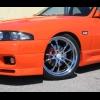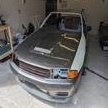Hks 2.8l Stroker Kit (in Rb26)
Announcements
-
Similar Content
-
Latest Posts
-
Because people who want that are buying euros. The people with the money to buy the aftermarket heads and blocks aren’t interested in efficiency or making -7 power, they’re making well over 1,000hp and pretty much only drive them at full throttle best way to way make money is know your customer base and what they want and don’t spend money making things they don’t want.
-
By joshuaho96 · Posted
It's not, but it does feel like a bit of a missed opportunity regardless. For example, what if the cylinder head was redesigned to fit a GDI fuel system? It's worth like two full points of compression ratio when looking at modern GDI turbo vs PFI turbo. I'm pretty reliably surprised at how much less turbo it takes to make similar power out of a modern engine vs something like an RB26. Something with roughly the same dimensions as a -7 on an S55 is making absolutely silly power numbers compared to an RB26. I know there's a ton of power loss from things like high tension rings, high viscosity oil, clutch fan, AWD standby loss, etc but it's something like 700 whp in an F80 M3 vs 400 whp in an R33 GTR. The stock TF035HL4W turbos in an F80 M3 are really rather dinky little things and that's enough to get 400 whp at 18 psi. This just seems unwise no? I thought the general approach is if you aren't knock limited the MFB50 should be held constant through the RPM range. So more timing with RPM, but less timing with more cylinder filling. A VE-based table should accordingly inverse the VE curve of the engine. -
By Dose Pipe Sutututu · Posted
I've seen tunes from big name workshops with cars making in excess of 700kW and one thing that stood out to me, is that noone is bothering with torque management. Everyone is throwing in as much timing as the motor can take for a pull. Sure that yields pretty numbers on a dyno, but it's not keeping these motors together for more than a few squirts down the straight without blowing coolant or head gaskets. If tuners, paid a bit more attention and took timing out in the mid range, managed boost a bit better, you'll probably see less motors grenading. Not to name names, or anything like that, but I've seen a tune, from a pretty wild GT-R from a big name tuner and I was but perplexed on the amount of timing jammed into it. You would have expected a quite a bit less timing at peak torque versus near the limiter, but there was literally 3 degrees of difference. Sure you want to make as much as possible throughout the RPM range, but why? At the expense of blowing motors? Anyhow I think we've gone off topic enough once again lol. -
Because that’s not what any of them are building these heads or blocks for. It’s to hold over over 1000hp at the wheels without breaking and none of that stuff is required to make power
-
Dort sounds above 3k rpm are dorty 🤣 I might krinkle black the alloy 🤔
-






Recommended Posts